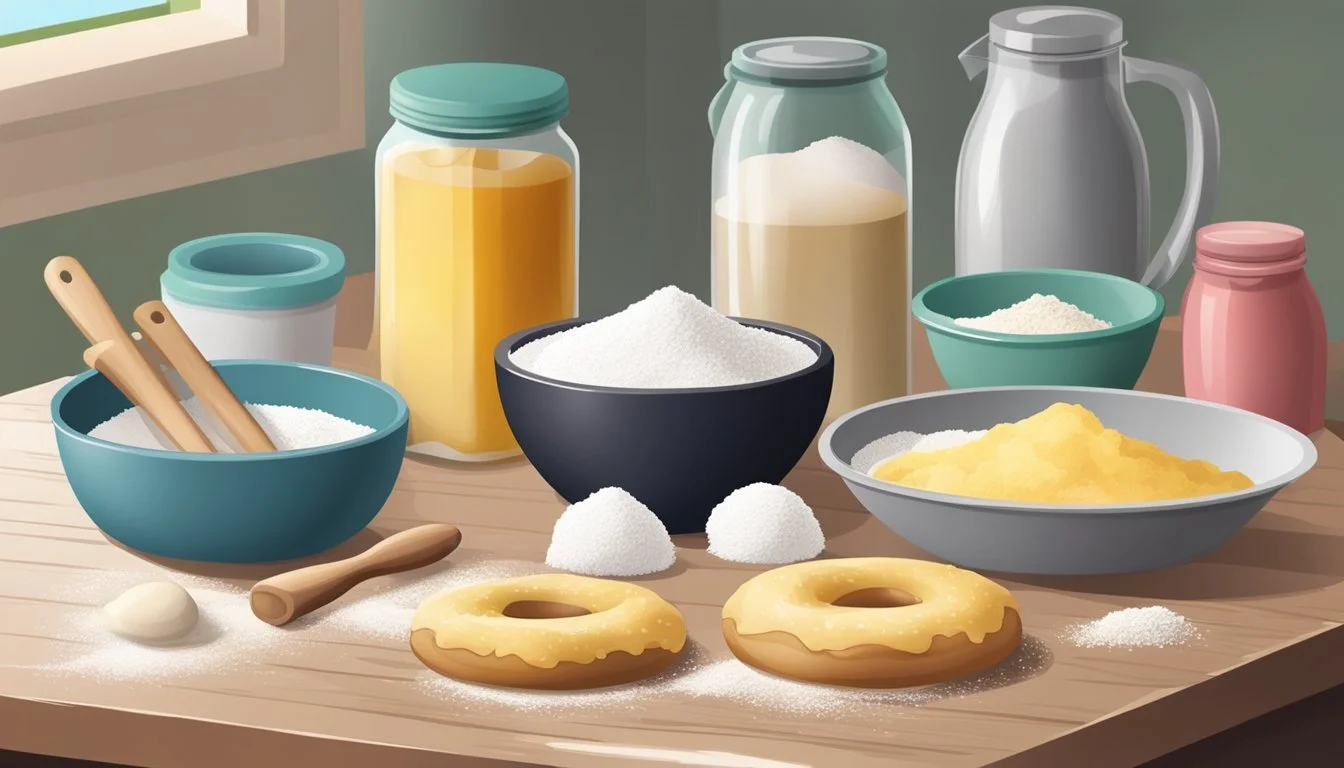How do you eat a doughnut?
Unveiling the Art of Savoring This Sweet Treat
Eating a doughnut is a simple pleasure enjoyed by many, but even within this sugary realm, there is room for personal preferences and techniques. The doughnut, or donut as it's sometimes spelled, comes in a wide variety of flavors, shapes, and sizes, which can influence how one might choose to consume this iconic treat. While there is no single correct method to eat a doughnut, some approaches can enhance the experience.
When deciding how to eat a doughnut, people should consider the texture and toppings. For doughnuts boasting a rich glaze or elaborate toppings, one might want to bite directly into it to relish the combination of soft dough with the icing. On the other hand, with filled doughnuts, it can be strategic to take a bite near the center to ensure a taste of the filling with the doughy exterior. Eaters often appreciate the sensory experience of a doughnut, from its visual appeal to the sound of a crispy exterior or the aroma of freshly baked dough.
Choosing the right bakery also plays a crucial role in one's doughnut experience, as the quality can vary greatly between establishments. It’s beneficial for aficionados to select a bakery with a reputation for freshness and variety. Whether pulling apart a doughnut to savor each piece or biting into the sumptuous treat as a whole, doughnut-eating is as much an art as it is a culinary delight. They may wish to pair their doughnut with a beverage, such as coffee or milk, to complement the flavors and textures of the doughnut, making the eating experience even more enjoyable.
Doughnut Varieties
Doughnuts come in an array of flavors and textures, each with their own unique preparation and cooking methods. From the classic cake variety to the light and fluffy yeast-raised, there's a doughnut to satisfy every palate.
Cake Doughnuts
Cake doughnuts are made with a batter that includes baking powder as a leavening agent, which gives them a denser structure compared to yeast varieties. They can be baked or fried and often have a slightly crispy exterior. Ingredients like buttermilk or sour cream are commonly used to enhance flavor and texture. These doughnuts may be finished with a glaze or a dusting of sugar and are generally served at room temperature.
Yeast-Raised Doughnuts
Yeast-raised doughnuts are known for their airy, light texture due to the fermentation process of the yeast. The dough is typically allowed to prove, creating the signature fluffiness and softness. Once fried, they present a golden-brown exterior with a tender crumb. Glazes, icings, or sugar coatings are frequently applied to yeast doughnuts to add a sweet touch.
Filled Doughnuts
Filled doughnuts are often based on yeast dough and come packed with a variety of fillings such as jam, custard, or chocolate. The fillings are injected after the doughnuts have been cooked and cooled slightly. They are usually round without a hole in the middle, and their exterior may be garnished with powdered sugar or a simple glaze to hint at the sweetness inside.
Specialty Types
Specialty doughnuts encompass a broad category that includes regional and cultural variations like apple fritters, mochi doughnuts, and pączki. Apple fritters, for instance, combine chopped apples with a cinnamon-spiced batter and are deep-fried until crisp. Mochi doughnuts include rice flour in their recipe, offering a chewier texture. Pączki, a Polish tradition, are rich, filled doughnuts that are especially popular on Fat Thursday and Fat Tuesday, the last days of the carnival season.
Ingredients & Alternatives
When crafting the perfect doughnut, one must consider the foundational ingredients that give doughnuts their signature taste and texture. For those with dietary restrictions or preferences, various alternatives offer ways to enjoy this classic treat without compromising on flavor.
Essential Ingredients
The quintessential doughnut starts with flour, granulated sugar, butter, and eggs. These ingredients form the dough, which is deep-fried in oil to create its distinctive crispy exterior and soft interior. Milk often enriches the dough, while vanilla extract adds flavor.
Flour: Typically, all-purpose flour is used for its ability to create the proper texture.
Sugar: Granulated sugar sweetens the dough.
Leavening Agents: Bakers often use yeast or baking powder to help doughnuts rise.
Fat: Butter adds richness to the dough, while oil, such as canola or coconut, is used for frying.
Liquid: Milk is commonly used, but water may also be included in some recipes.
Gluten-Free Options
For those avoiding gluten, gluten-free all-purpose flour can be used as a substitute for traditional flour. Bakers might also combine different gluten-free flours like rice or almond flour to mimic the texture that wheat flour provides. It's crucial to ensure that other ingredients such as baking powder and vanilla extract are also gluten-free.
Alternative Flours: Almond, rice, or a gluten-free blend can substitute all-purpose flour.
Binding Agents: Xanthan gum may be needed to replace gluten's binding properties.
Vegan Variations
Vegan doughnuts omit animal products, utilizing substitutes such as almond milk instead of dairy milk and coconut oil in place of butter. There are also egg replacements available, ranging from commercial egg substitutes to flax or chia seeds mixed with water.
Non-Dairy Milk: Almond milk, soy milk, or oat milk can replace cow's milk.
Vegan Butter: Use plant-based butter alternatives.
Egg Replacements: Flaxseed meal or commercial egg replacers can be used to bind the ingredients together without eggs.
Doughnut Making Basics
Making doughnuts at home involves a series of steps that, when followed carefully, result in a delicious treat. The process includes preparing the dough, shaping the doughnuts, allowing them to rise properly, and choosing the right cooking method.
Preparing the Dough
The foundation of a good doughnut is the dough. This usually starts with activating the yeast, such as active dry yeast. In a small container, mix the yeast with warm water (around 110 F) to dissolve it, allowing it to become frothy, indicating that it's alive and ready to work. Then, in a stand mixer, one would combine wet ingredients like whole milk and eggs with dry ingredients including flour, sugar, and salt. Mixing and kneading are critical to developing the dough's texture, which should be smooth and slightly sticky.
Shaping Doughnuts
Once the dough is made, it's time to shape it. After it has been rolled out to the right thickness, usually about half an inch, a doughnut cutter is used to punch out the classic doughnut shape. Leftover dough is re-rolled and cut again until all of it is used. Additionally, this method also creates doughnut holes from the punched-out centers.
Proofing and Rising
After shaping, doughnuts need to be left to first rise. This is done under plastic wrap at room temperature to protect them from drying out. This process allows the dough to puff up, becoming airy and light - the hallmarks of a good doughnut. This stage generally takes between 30 minutes to an hour, depending on the recipe.
Cooking Methods
Cooking doughnuts can be done in a number of ways. Deep frying is traditional and involves submerging the doughnuts in oil kept at a steady temperature, usually between 350 F and 365 F - a culinary thermometer is crucial here. Frying times are short, often just a few minutes per side. Alternatively, those looking for a healthier option may opt to bake the doughnuts in an oven pre-heated to around 350 F, or even use an air fryer. Each cooking method creates a distinctive texture and flavor profile.
Decoration and Toppings
When it comes to doughnuts, the decoration and toppings not only add visual appeal but also enhance flavors and textures. This section walks through the fundamental techniques of glazing and icing, followed by how to artfully add toppings.
Glazing and Icing
Glazing provides a sweet, shiny coating that can be flavored in various ways. A basic glaze consists of powdered sugar and water, milk, or juice, mixed until smooth. It should be just thin enough to pour but thick enough to coat the doughnut. For a richer flavor, chocolate ganache made from melted chocolate and cream serves as a decadent alternative. An icing may include more substantial ingredients like cream cheese or butter, and can be spread or piped onto the doughnut for added texture.
Adding Toppings
Once glazed or iced, a doughnut can be immediately dipped into or sprinkled with a myriad of toppings. This is when one can get creative:
Sprinkles: Classic and colorful, they add a playful crunch.
Cinnamon and Sugar: A popular combination, providing a sweet spice.
Nuts: Chopped almonds, pecans, or walnuts for a nutty crunch.
Fruit: Fresh or dried fruit such as blueberries or coconut flakes for a natural sweetness.
Extras: Toppings like crushed cookies or cereal can create a unique texture and flavor profile.
The key when adding toppings is to do so while the glaze or icing is still wet to ensure they adhere well. A balance in flavors and textures makes for the perfect bite every time.
Serving and Pairing
When it comes to enjoying doughnuts, pairing them with the right beverage or side can elevate the entire experience. The choices range from the classic coffee to more inventive culinary combinations.
Coffee and Doughnuts
Coffee and doughnuts are a classic pairing. The bitterness of the coffee balances the sweetness of the doughnut. Dunking a doughnut into coffee is not only traditional but also enhances the flavors of both. They prefer a medium-roast coffee for a smooth taste, or a dark roast for a robust complement to a sweet, glazed treat.
Light Roast: Best with fruity or lighter doughnuts
Dark Roast: Pairs well with chocolate or rich, filled doughnuts
Dairy Pairings
Dairy products such as milk and cheese make excellent companions to doughnuts. A glass of cold milk is perfect for mellowing the doughnut's sweetness, while the creaminess of milk complements the doughnut's texture. Additionally, unconventional yet delectable, cheese offers a savory contrast to the sweet treat—think of a cheese plate with a variety of textures and flavors to create a sophisticated snack.
Whole Milk: Ideal for softening sugary flavors
Cheese: Opt for bold cheeses for an adventurous taste contrast
Creative Pairings
Moving beyond the norms, one can explore creative pairings with doughnuts:
Ice Cream Sandwiches: By placing a scoop of one's favorite ice cream between two doughnut halves, they get an upscale twist on the classic cream-filled doughnut. It's a playful take on dessert that's as delightful to taste as it is messy to eat.
Yogurt Parfaits: For a lighter option, a yogurt parfait with granola and fruit adds a healthy note to the indulgence of a doughnut. Greek yogurt's tang and crunch make it an especially good choice to pair with the sweetness of doughnuts.
Nutritional Considerations
When indulging in doughnuts, it is important for consumers to be aware of the nutritional content, particularly the caloric content and the type of fats present. These factors can vastly affect the overall health impact of enjoying this treat.
Caloric Content
Doughnuts come in a variety of shapes and sizes, and their caloric content can vary significantly. A standard glazed doughnut approximately 4 inches in diameter typically contains around 253 calories. However, this can escalate to 400-500 calories for doughnuts with additional fillings or toppings. For those tracking their caloric intake, this is a crucial consideration.
Plain Glazed Doughnut: About 253 calories
Filling/Topping Enhanced Doughnut: Up to 500 calories
Reducing Unhealthy Fats
Doughnuts are often fried in oils such as canola oil or vegetable oil, which may contain trans fats. Trans fats are known for their negative impact on heart health. One way to reduce unhealthy fat consumption is to seek out doughnuts made with unsalted butter or oils that are free of partially hydrogenated fats.
Common Cooking Oils:
Canola oil
Vegetable oil
By choosing doughnut options fried in healthier fats and being mindful of portion sizes, consumers can better manage the nutritional impact of these sweets.
Storage and Freshness
Maintaining the freshness of doughnuts is essential to enjoy their optimal texture and taste. Proper storage methods can significantly extend their shelf life and ensure that they remain as delicious as when first purchased.
Keeping Doughnuts Fresh
For immediate consumption, doughnuts should be stored at room temperature. They are best enjoyed within 1-2 days when placed in an airtight container or sealed plastic bag to protect from air exposure. It's important to avoid sunlight and any warm areas that can accelerate staleness. If doughnuts need to be kept fresh beyond a couple of days, they can be refrigerated for up to a week. In this case, wrapping them individually in plastic wrap or placing them in an airtight container with a layer of paper towel to absorb excess moisture is advisable.
Freezing and Reheating
Doughnuts can be frozen to extend their shelf life for up to two months. To freeze doughnuts:
Prepare them for freezing: If needed, separate layers with wax paper to prevent sticking.
Store them properly: Place the doughnuts in a freezer bag, removing as much air as possible to prevent freezer burn.
Reheat for serving: When ready to eat, they can be thawed at room temperature. For a fresh from the bakery experience, reheating in an oven at 350°F for just a few minutes can restore their warmth and texture.
Following these storage guidelines, one can ensure that doughnuts retain their delectable taste and texture for longer periods.
Homemade Doughnut Tips
Making doughnuts at home can be a rewarding weekend baking project. With the right tools—like a wooden spoon, stand mixer, rolling pin, and a deep fryer—any home baker can whip up a batch of delicious homemade doughnuts. The following subsections offer specific techniques and solutions to common challenges encountered in the process.
Do-It-Yourself Techniques
Choosing the Right Recipe: One must select a recipe that matches their skill level and kitchen tools. For yeast doughnuts, ensure that the recipe allows for proofing time.
Prepping the Dough: Utilizing a stand mixer can significantly ease the process of kneading the dough to the right consistency—smooth, elastic, and slightly tacky.
Rolling & Cutting: A rolling pin is crucial for achieving uniform thickness before cutting out the doughnuts. They should aim for about 1/2 inch thickness for optimal puffing during frying.
Frying the Doughnuts: A deep fryer or a heavy-bottomed pan with at least 2 inches of oil is ideal. The oil temperature should be maintained around 360°F (182°C) for even cooking.
Troubleshooting Common Issues
Oil Temperature Control: If the oil is not hot enough, doughnuts may become too greasy; if it's too hot, they will burn on the outside before cooking through. Monitoring with a thermometer can prevent this.
Dough Consistency: If the dough is too sticky, add flour a tablespoon at a time. Conversely, if it's too dry, they can mix in water a teaspoon at a time until it reaches the proper consistency.
Rising Issues: Should homemade doughnuts not rise properly, they should check the yeast's freshness and ensure the dough is kept in a warm, draft-free area during the proofing stage.
Shape & Size: Doughnuts may not keep their shape if the dough was overworked or not chilled before frying. Resting the cut doughnut shapes before frying can help maintain their form.
Ethical and Environmental Impact
When one considers the consumption of doughnuts, it's crucial to look beyond the immediate pleasure and consider the ethical and environmental impact of their production, specifically in terms of sustainable ingredients and eco-friendly packaging.
Sustainable Ingredients
Doughnuts can have varying impacts on the environment depending on their ingredients. For instance, those that contain trans fats and artificial flavors may contribute to adverse health outcomes, whereas doughnuts made with organic ingredients support ecological balance and reduce exposure to pesticides. Local sourcing of ingredients minimizes transportation emissions, supporting local farmers and reducing the carbon footprint. When selecting ingredients:
Organic Flour: Reduces pesticide use.
Local Eggs: Supports local agriculture.
Non-trans Fat Oils: Better for heart health.
Eco-Friendly Packaging
Packaging plays a significant role in the environmental impact of doughnut consumption. Traditional plastic and styrofoam materials can take centuries to degrade, contributing to pollution and harm to wildlife. In contrast, parchment paper or biodegradable materials offer a more sustainable solution, breaking down much more quickly and with fewer negative environmental effects. Points to consider for packaging choices:
Parchment Paper: Biodegradable and often compostable.
Recycled Paper Boxes: Minimize waste and resource use.
By focusing on these aspects, consumers can enjoy doughnuts while also supporting environmental sustainability and ethical practices.










